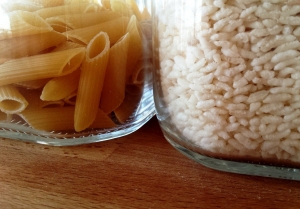Carbohydrates are often demonized by the media and diet culture as being a source of weight gain. Low-carb diets are more popular than ever. It started with the rise of the Atkins diet in the early 2000s, and by the time that fizzled out the Keto diet came to fame in 2013. Are carbs really the enemy that we have made them out to be? Let’s find out.
Carbs are often avoided by many who are wanting to lose weight. This usually involves skipping processed and simple carbs such as pasta, bread, cookies, cake, donuts — you get the point. However, carbs are virtually impossible to avoid as an entire macronutrient category. They are found in all plant foods including fruits, vegetables, whole grains, nuts and seeds, beans, and legumes. They are also found in dairy products — the only animal food containing carbohydrates in the form of sugars (i.e., lactose).
Processed carbohydrates are detrimental to our health when consumed on a long-term basis as they often contain high amounts of added sugars, fat, and preservatives. They typically spike blood sugar and over time, erratic blood sugar levels can lead to prediabetes and diabetes, hormone dysregulation, fatigue, weight gain, brain fog, and more. Unprocessed and unrefined carbs in the forms of whole grains, fruits, vegetables, nuts, seeds, beans, and legumes are foods that will digest slowly and allow for a steady supply of energy, avoiding those drastic highs and lows in blood sugar. These foods are typically also rich in fiber as well as carbs.
Let’s look at the 4 different categories of processed foods:
- Unprocessed or minimally processed foods are slightly altered for the main purpose of preservation without altering the nutritional content of the food. This includes cleaning or removing inedible parts, refrigerating, pasteurization, fermentation, freezing, and vacuum sealing. This category includes many fresh fruits and vegetables, whole grains, nuts, meats, and milk.
- Processed culinary ingredients are ingredients derived from a minimally processed food by pressing, refining, grinding, or milling. They are used as ingredients in preparing meals or dishes. Some examples include oils made from seeds, nuts, or plants or flours made from whole grains. These items are typically not eaten on their own.
- Processed foods are foods that have added salt, sugars, or fats. This includes some canned fruits and vegetables, cheeses, and fresh bread. These foods can be eaten without further preparation and are made from at least 2 or 3 ingredients.
- Ultra-processed foods are foods that have the same qualities as processed foods but also have added colors, preservatives, and flavors. They are more shelf-stable and palatable due to the preservation of tastes and textures through added ingredients. Some examples are chips, cookies, crackers, cereals, lunch meats, and frozen meals.
Due to the way most food is processed — generally, the more processed the food is, the less of its original benefits it is able to maintain. This includes the loss of vitamins, minerals, and fiber as well as the addition of salt, sugar, fat, preservatives, colors and dyes, and more.
Food for Thought:
Brown rice is a whole grain that would fall into the unprocessed/minimally processed food category. When brown rice is stripped of the husk, bran, and germ to leave the starchy endosperm we get white rice. This is still a minimally processed food on its own, but when you buy something such as a white rice kit that comes with a spice packet or flavor packet such as Rice-A-Roni, becomes an ultra-processed food. This is a great example of minimally processed food not being the best option and how a minimally processed food can become an ultra-processed food with the addition of a spice or flavoring packet.
Fiber is needed for healthy digestion and elimination. Fiber also acts as a prebiotic; this feeds the good bacteria in our microbiome. Your microbiome is the trillions of bacteria that live in your digestive tract. By feeding these good ‘gut bugs’ they repay us by producing things like:
- Short-chain fatty acids — SCFAs for short, these molecules are vital for maintaining the health and integrity of the gut lining. These are the preferred fuel source for colonocytes AKA the cells that line the inside of your intestines. Unhealthy or weak intestinal walls can lead to issues related to food sensitivities, vitamin and mineral deficiencies, autoimmune diseases, and more.
- Vitamin K — Vitamin K is synthesized within the GI tract, specifically in the large intestine. Specific bacteria synthesize Vitamin K2 and this vitamin is used in the body for blood clotting and coagulation.
- Vitamin B1— B vitamins are water-soluble, meaning that we do not have the ability to store them within the body as efficiently as fat-soluble vitamins A, D, E, and K. Those of us who are under high stress, taking certain medications, or lacking a diverse diet burn through these B vitamins even faster than usual. Approximately half of the microbes in your microbiome are able to produce thiamin (B1) from scratch using protein building blocks.
How do carbs benefit our mental health?
Well, some of the most important hormones and neurotransmitters for optimal mental health are also synthesized in the GI. Chemicals such as serotonin (the happy hormone) are synthesized there. The brain and gut have a deep connection that many people do not recognize. There is bidirectional communication between the two through the vagus nerve, immune system, SCFA production, and more. What does this mean? It’s a two-way street. The gut communicates to the brain and the brain to the gut. This is why many people with conditions such as anxiety experience digestive issues.
If you or someone you know has ever taken medication for depression, there’s a good chance it was as SSRI (selective serotonin reuptake inhibitor). Many people fail to see that without serotonin readily available to reuptake, the patient will get little effect from this medication. Eating a diet rich in complex carbohydrate-rich foods such as fruits, vegetables, whole grains, nuts, seeds, beans, and legumes will feed those good bacteria with fiber and they will benefit you right back.
Sarah’s Story:
Sarah was suffering from anxiety and mild depression and was seeking to try some natural remedies. She had learned about the importance of the microbiome and was looking to focus on this area of her health to help improve her symptoms. She was taking a high-quality probiotic but saw little improvement. Upon consulting a nutrition professional, she was guided in switching up her diet to remove processed and ultra-processed foods, inflammatory foods, and foods that came back as reactive on her food sensitivity test. She replaced many of the packaged and prepared foods she was having with unprocessed and minimally processed options. In just a short time she experienced mental clarity, her skin improved, her digestion was better than ever, and overall, she was feeling so much better. By feeding those good ‘gut bugs’ she was able to reap the benefits of the high-quality probiotic because she was not only repopulating with beneficial bacteria but also giving them the food that they want and need to benefit us in return. Sarah now maintains a diet rich in fruits, vegetables, whole grains, lean proteins, nuts, seeds, beans, and legumes. She has seen the value and importance of whole foods, fiber, and taking care of her microbiome through food.
If you are interested in learning more about the interplay between nutrition and mental health, please contact us at 201-488-6678 or visit https://www.specializedtherapy.com/. We look forward to speaking with you!
Bastiaanssen, T., Cowan, C., Claesson, M. J., Dinan, T. G., & Cryan, J. F. (2019). Making Sense of … the Microbiome in Psychiatry. The international journal of neuropsychopharmacology, 22(1), 37–52. https://doi.org/10.1093/ijnp/pyy067
Kazemian, N., Mahmoudi, M., Halperin, F., Wu, J. C., & Pakpour, S. (2020). Gut microbiota and cardiovascular disease: opportunities and challenges. Microbiome, 8(1), 36. https://doi.org/10.1186/s40168-020-00821-0
Putnam, E. E., & Goodman, A. L. (2020). B vitamin acquisition by gut commensal bacteria. PLoS pathogens, 16(1), e1008208. https://doi.org/10.1371/journal.ppat.1008208
Swann, O. G., Kilpatrick, M., Breslin, M., & Oddy, W. H. (2020). Dietary fiber and its associations with depression and inflammation. Nutrition reviews, 78(5), 394–411. https://doi.org/10.1093/nutrit/nuz072


